The Psychology Of Skyscrapers
Could living in the sky subtly influence our perspective of space, distance, and height?
“Living in high-rises required a special type of behavior, one that was acquiescent, restrained, perhaps even slightly mad.” So declares the protagonist (rather presciently, a producer of television documentaries) of J. G. Ballard’s 1975 novel High-Rise, a dystopian fable, set in a tall luxury building outside central London, whose rational architecture and enveloping all-mod-cons embrace cannot ultimately contain the social rot within. Ballard, the self-declared cartographer of “inner space,” diagnosed the maladies of this “small vertical city,” whose residents “thrived on the rapid turnover of acquaintances, the lack of involvement with others, and the total self-sufficiency of lives which, needing nothing, were never disappointed.” Here was a vast machine “designed to serve, not the collective body of tenants, but the individual resident in isolation.” It was “civil inattention”—the sociologist Erving Goffman’s phrase for the way people cohabiting dense environments studiously ignore each other—run amok.
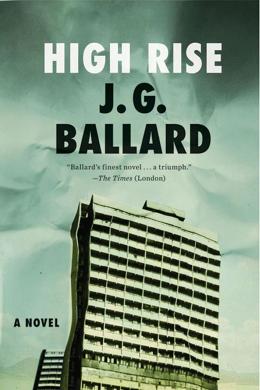
Ballard, who lived in a small detached house in the anodyne suburb of Shepperton, had his own proclivities and prejudices, his suspicions of modern urban life. But High-Rise, like most of Ballard’s “science fiction,” hardly required huge leaps of imagination. The novel’s protagonist, contemplating a documentary that would “look at the psychology of living in a community of 2,000 people boxed up into the sky,” goes on to declare: “All the evidence accumulated over several decades cast a criticallight on the high-rise as a viable social structure, but cost-effectiveness in the area of public housing and high profitability in the private sector kept pushing these vertical townships into the sky against the real needs of their occupants.”
This far from feverish speculation could have been ripped from a sociological journal of the day—or the headlines. Minoru Yamasaki’s Pruitt-Igoe public housing complex in St. Louis was being slowly and spectacularly demolished. Residents in cities like San Francisco were resisting what they saw as a physical and psychic occupation of the city’s soul by tall buildings (as one report noted, a survey of downtown office workers “showed a large percentage of them to feel personally oppressed by the buildings around them”). Critics such as Ada Louise Huxtable had charged that “perhaps the most appalling characteristic of the skyscraper is its inhumanity.” Films like The Towering Inferno depicted skyscrapers as the embodiment of reckless vanity by egomaniacal developers and narcissistic architects (images of the safari-jacketed Paul Newman, waving off nettlesome subordinates, repairing from his office to the adjoining boudoir, where Faye Dunaway beckons him toward the satin-sheeted bed).
Ballard himself was said to have been inspired by London’s Trellick Towers, Erno Goldfinger’s 31-story tower block in North Kensington, completed in 1972 and almost instantly a symbol for urban social pathology (buildings like Trellick, or London’s Alton Estate, notes critic Owen Hatherley, very quickly became the “mute, imposing backdrop” to the grim totalitarianism in François Truffaut’s Fahrenheit 451 and other films). As in High-Rise, in which the complex’s architect himself occupies the structure’s penthouse, Goldfinger actually briefly lived in the Trellick’s predecessor building, the Balfron Tower, to “publicize its qualities.”
The year Ballard’s novel was published, I was seven years old and living in suburban Chicago. On trips to the city I would gaze with fascination, from the backseat of the family Monte Carlo, upon the two typologies of high-rise living. Situated at extremes of geography and demography, both were imposingly remote from and mysterious to my own split-level, single-family suburban mental maps.
First, arrayed along the Dan Ryan Expressway like a set of coastal bunkers, were the Robert Taylor homes, a bleak and unrelenting wall of 28 hulking tower blocks, exterior hallways encaged like prison floors, their façades a flat expanse of dun-colored concrete, save for fire-scarred black shadows flaring from certain windows. In the city itself, just adjacent to the Loop on the banks of the Chicago River, were the two corn-cob-like silos of Bertrand Goldberg’s Marina City, which looked to me like futuristic incubators for urban living. When completed in 1964, they were not only the world’s tallest concrete structures, but also the tallest residential towers. Never—not even in the city where the skyscraper was born—had people lived in such aerial splendor. Marina City’s round shape was dictated by practical, floor-area-to-exterior-surface concerns; but also, according to Goldberg, something deeper. “I wanted to get people out of boxes, which are really psychological slums … those long hallways with scores of doors opening anonymously are inhuman. Each person should retain his relation to the core. It should be the relation of the branch to the tree, rather than that of the cell to the honeycomb.”
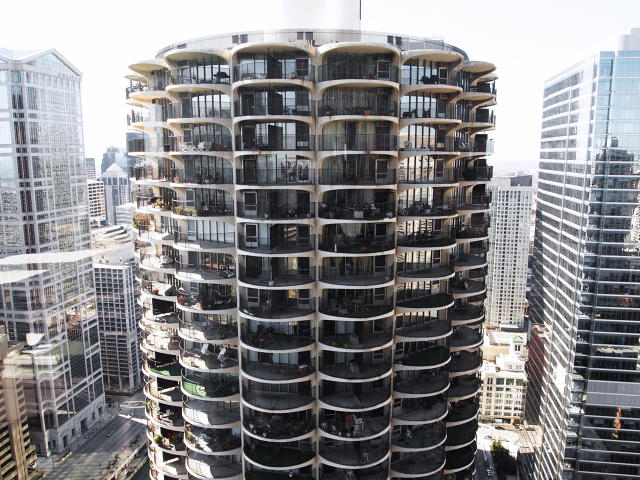
Both the Robert Taylor Homes and Marina City were responses, in high concrete, to pressing mid-20th-century urban conditions: providing affordable housing, largely for the Great Migration of African Americans from the South to the North (with the spatial goal, as Nicholas Lehman notes in his book The Promised Land, “to keep as many of the migrants as possible apart from white Chicago”). Marina City was, arguably, the other side of the coin: an attempt to stem the departure of mostly white, higher-income residents from the central metropolis, a Corbusian Unité city-within-a-city with its own supermarket, a bowling alley, and, most excitedly to my juvenile mind, a circular parking garage twisting beneath the residents in the very same structure.
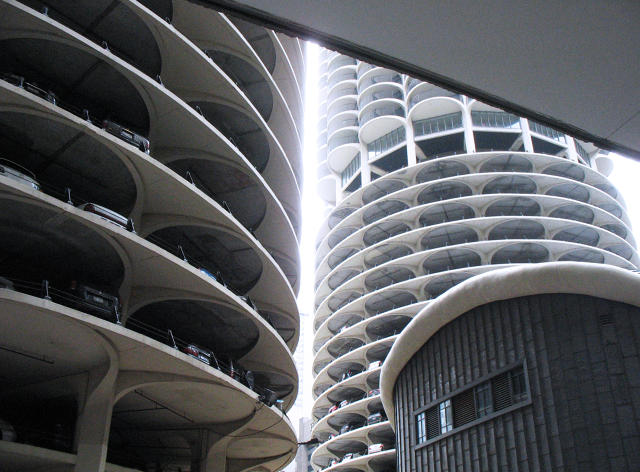
As it happened, the multi-story car park, too, was a source of dark fascination for Ballard. “One of the most mysterious buildings ever built,” as his novel Crash (the predecessor to the 1996 film) declares.”Is it a model for some strange psychological state, some kind of vision within its bizarre geometry?” His next question could have been directed as much at high-rise living as high-rise parking: “What effect does using these buildings have on us?”
Why should we even think that high-rise living has an effect on us? One does not, after all, see detailed psycho-architectural studies of ranch houses. The primary reason may be sheer novelty. “Given the age of our species, living more than a few stories up is a very recent phenomenon,” writes Robert Gifford in Architectural Science Review. “This tempts one to conclude that high rises are unnatural, and some would argue that what is unnatural must be, in some way, harmful.”
It is easy to find de facto condemnations of height, like this, from Christopher Alexander, in A Pattern Language: “In any urban area, no matter how dense, keep the majority of buildings four stories high or less. It is possible that certain buildings should exceed this limit, but they should never be buildings for human habitation.” Alexander, verging into Ballard-esque territory, further warns: “The higher people live off the ground, the more likely they are to suffer mental illness.”
There seems to be a lingering, Babel-inflected mixture of awe and unease with the idea of “livingin the sky.” It is easy to look at the images in photographer Michael Wolf’s book The Transparent City and see nothing but dehumanization, huge structures housing small Edward Hopper figures leading lives of collective solitude, nestled together in their separate window frames before our eyes like some split-screen narrative from an Altman film, but unknown to each other. In Ayn Rand’s Atlas Shrugged, protagonist Dagny Taggart, sitting in her high, Roarkian office, looks at other distant skyscrapers, wondering from which one her would-be love interest might be watching her. “Just to know that you’re seeing me, even if I’m never to see you again.” Notions of public and private, distance and intimacy, are blurred in the age of the tall glass tower.

Perhaps there is something in height itself behind the blurring. As one of the authors in a collected 1977 volume, Human Response to Tall Buildings, noted: “How visual separation might relate symbolically to psychological separation cannot be guessed at this time.” But he quotes the environmental psychologist Edward T. Hall: “At the distance people look like ants, contact with them as human beings fades rapidly.” One thinks of the nefarious Harry Lime in The Third Man, in a Ferris wheel high above Vienna, looking down and asking Holly Martins, with cold contempt, “Would you really feel any pity if one those dots stopped moving forever?”
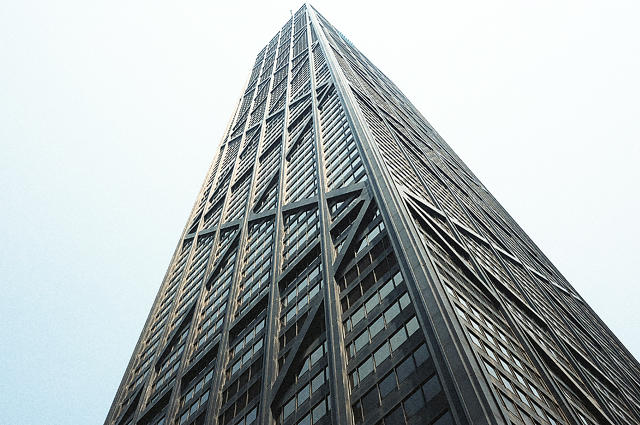
Conversely, people living in tall buildings tend to speak—perhaps not surprisingly, as they have chosen to live there—of the ennobling qualities of height. Early residents of the John Hancock building in Chicago (then, looking down on Marina City, the world’s highest residents) described the sensation as “being in the country,” or in the “fifth dimension.” An advertising executive with children marveled how he was spending more time with his family now that his commute was simply down the elevator to the 27th floor. In one account, a resident, “having left a home in the suburbs for the tower, had taken an interest in nature after his move to the city. Now with his expansive view of lake and sky, he could watch the sun ride over the lake, the stars and moon in the sky, and the annual migration of birds.”
So how to square this with a body of research that seems to conclude that most people find high-rise living less satisfactory than low-level living; that tall buildings seem to breed more crime than their lower-situated counterparts; that small children seem to develop (by reading and other measures) less quickly the higher up they live; that tall buildings might even invite suicide? Could an architectural form really do all that? Architecture is never more than a container for social relations. And so high-rise sociology is troubled by larger factors—who is living in the high-rise, and under what conditions? Pruitt-Igoe became synonymous with the problems of high-rise housing; it was considered the death knell of modernist social planning and modern architecture all at once. The backward, revisionist look has been more nuanced.
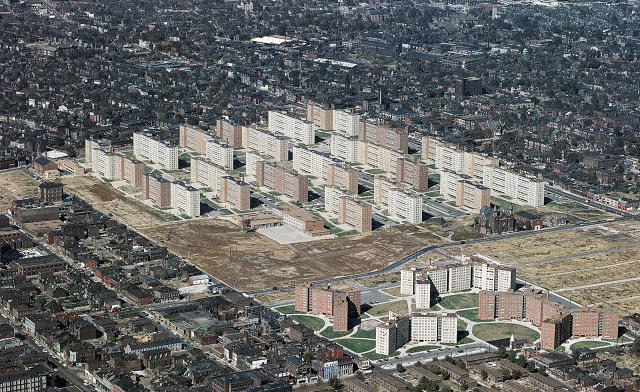
In Chad Friedrich’s documentary film, The Pruitt-Igoe Myth, residents tenderly recall the “poor man’s penthouses” they were moving into; of feeling safe surrounded by so many other sets of residents. But soon, the elevators stopped working, vandalism set in, strangers lurked in stairwells. Was there something inherent in its form that caused the decay to set in? Jane Jacobs argued that these tall buildings were “streets piled high in the sky,” but without the public view ground-level streets enjoyed, and so lacking “the checks and inhibitions exerted by eye-policed city streets.” Curiously, the equally lamented Trellick Towers—once as much a negative symbol as Pruitt-Igoe—have seen a remarkable turnaround: they are now a heritage-listed, increasingly desirable place to live. The turning point came in the early 1990s with the formation of a residents’ association and the installation of front-desk security (a seeming no-brainer, per Jacobs, but something that was once frowned upon by the Greater London Council). Far from isolation, Trellick now seems to pulse with fellow-feeling. One resident makes a curious connection between community and height: “London sprawls below in all directions as far as the eye can see so maybe we need to know we’re not alone up here.”

Much of the research about the problems of tall-building living is really research about, as the sociologist Gerda Wekerle put it, “the problems created by concentrating multi-problem families in housing stigmatized by the rest of society.” Other studies have looked at the populations of places like dormitories, which are themselves hardly representative. The high-rise form is endlessly skewed by social extremes. As Wekerle argues, “Pruitt-Igoe is no more representative than is the John Hancock Center of high-rise living.” And then there’s context. In places like Singapore or Hong Kong, tall-building living is not only the norm, it is considered socially prestigious. A friend who grew up on the 19th floor of an Upper East Side New York City apartment building (and who, interestingly, grew up to be an architecture critic) finds nothing odd, in retrospect, about his upbringing; most of his friends, after all, lived in similar circumstances, if not in the very same building. Why would you need a suburban lawn, he suggested, when Central Park was five minutes away? In terms of building height, he notes: “I don’t think it really had much effect one way or another, perhaps because so many of the neighboring buildings were of relatively equal height, so there wasn’t a sense of vertigiousness.” For the record, he seems to read very well.
Of course, the 19th floor may begin to seem rather low-rise. All over the world, there has been a proliferation of very tall residential buildings. In New York City alone, these now range from Frank Gehry’s 76-story Spruce Street tower to Christian de Portzamparc’s 1,000-foot-tall One57 to Rafael Viñoly’s nearly 1,400-foot-tall 432 Park Avenue to SHoP’s planned 1,400-foot-plus 111 West 57th Street, all of which will provide, when completed, the highest possible living-places in the Western Hemisphere. Granted, units in these “airplane view” structures may be more safe-haven pied-à-terre (which means, ironically, “foot to the ground”) for the global 1% than demographically mainstream housing. But everywhere there is a clear trend at work. In 2012, an estimated 41 of the world’s 100 tallest buildings were offices; a decade previously, the figure was twice that.

In the late 1970s, Fazlur Kahn, the structural engineer behind both the Sears (now Willis) Tower and the John Hancock Building, said: “Today, without any real trouble, we could build a 150-story building. Whether we will, and how the city will handle it, is not an engineering question, it is a social question.”
A few decades later, Mark Lavery, an engineer with BuroHappold in Dubai, was asked, at a conference on tall buildings, “What is the panel’s view on the environmental psychology of tall buildings?” In his response, he evoked the spirit of Kahn, saying human response was really “the most fundamental topic facing the future of supertall buildings,” that perhaps it is we who are “the only real barrier to how tall we will go.”
The supertall building, as Lavery noted to me, comes with its own special set of engineering circumstances. Apart from the obvious differences in seismic and wind loads, there is the idea that more services need to be distributed further along a vertical core. Things we now take for granted—like strong mobile phone connections—become strained at height. Elevators, for the moment, are at their limit: as they still rely on cables, the required housings simply become too large. And so we have systems of “local” and “express” elevators, in which users might have to change cars two or even three times (satisfaction decreasing with each transfer) just to reach or leave their homes. Elevator speeds have increased to some 50 feet per second, though Lavery suggests actual travel speeds may be lower. People’s discomfort seems to set in at above 30 feet per second, and there is also, he suggests, a large increase in cost for each minor increase in speed.
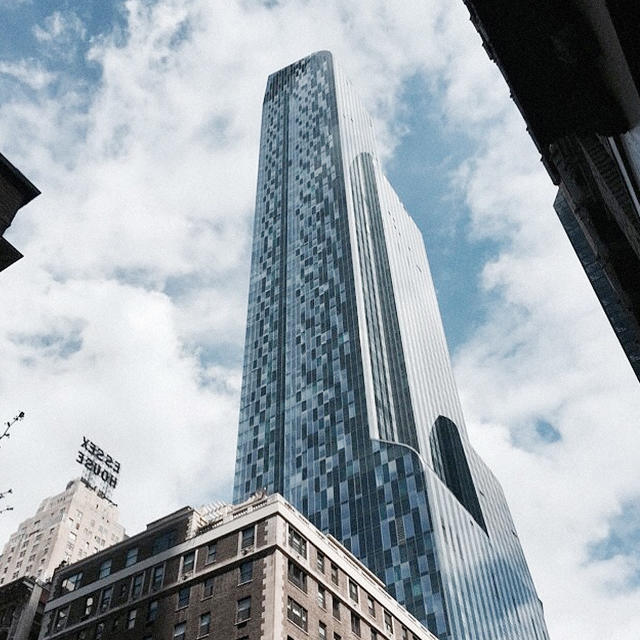
At a 2012 Council on Tall Buildings and Urban Habitat conference, a property developer noted that at the Shanghai Tower, the lifts travel 59 feet per second (by contrast, when Elisha Otis unveiled his first elevator in 1857, this exciting new form of vertical transport traveled 40 feet per minute). But, the developer noted, other things begin to happen at speed: “You are losing about four percent4% of atmospheric pressure for every 1,000 feet that you go up in the building. Your ears are going to pop and there is definitely going to be less air at the top of this lift than where you started.”
Elevator comfort is merely one of the ways engineering solutions are required to improve the psychological experience of inhabiting tall buildings. Wind effects grow more pronounced the higher the building goes; while these are lessened by any number of dampening technologies or architectural changes to the building’s profile, it is the human factor that remains perhaps the most critical. Human tolerance for “wind excited” buildings has been studied in countless wind-tunnel experiments (one early study surreptitiously vibrated an eye doctor’s office without informing visitors), with acceptable parameters laid out in the International Organizationfor Standardization’s ISO 6897, “or Guide to the evaluation of the response of occupants of fixed structures, especially buildings and off-shore structure, to low frequency horizontal motion.” Studies examining phenomena like “low frequency narrow-band random motion” have found that humans seem particularly susceptible to certain rhythms (“with 0.25 Hz and 0.50 Hz being the more provocative frequencies”). Individual thresholds vary—one person’s sick-making motion might be another’s gentle sway—and exposure is key: office workers, who would spend less time in a tall building, seem to tolerate more motion than residents. People walking experience less motion sensation than those standing (because, one study noted, “of the additional movement due to self-motion masking the sense of vibration”). Often, people seem to be looking out windows when they sense vibration (due to “involuntary body self-motion generating visual parallax while focusing on a far-field object against a near-field reference such as a window frame”).

The presence of strong winds means that tall building residences, in general, do not have balconies or operable windows. Containment is one of the peculiar hallmarks of super-tall living. “I’ve known buildings where they haven’t considered it and built buildings up to 500 meters [with balconies],” says Mark Lavery, “and they’ve had to go in and install alarm systems with automatic lock-in of doors to stop people from physically opening their doors on windy days.” And while high floors are most prized—more view, less noise—there comes, suggests Lavery, a sort of limit where the view no longer begins to appreciably improve with greater height, and may in fact get worse. “There’s the weather, and the view can get sort of warped, you start to lose your link to it. It doesn’t look real anymore.”
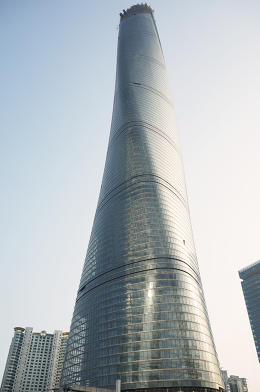
One wonders what psychological effects there might be to this earthbound living in the sky. Asthe architecture critic Joseph Giovannini observed, “Living on the 60th floor is different. There are no earthly sounds, no close-up details outside, not even trees—just the long view and then the drop.” Astronauts on NASA’s space shuttle Discovery, asked to draw three-dimensional cubes, drew them with shorter vertical dimensions when in the zero-gravity of space. Might living in the sky also subtly influence one’s perspective of space, distance, and height? Studies have shown that children, at 25 months of age, can transmit information gleaned from aerial views to make ground-level wayfinding decisions; at 21 months, however, they cannot. Would children whose homes come equipped with aerial views have an edge? It is known, for example, that people with a fear of heights—or even those without when shown images of people falling—will overestimate actual heights.
Do acrophiles actually experience the opposite effect? Do lovers of great heights feel closer to the ground than they really are? Does one’s apartment then feel larger the higher one goes up? And does this have to do with visual psychology or social psychology—the idea that you are living on top of so many others? Conversely, as Robert Gifford wonders, “Do people on lower floors experience the many floors above them as a sort of crushing burden?”
For now, we must still rely largely on anecdote. “I have a huge amount of space,” said one resident of Gehry’s 870-foot-high New York tower. “Not the square footage of my moderate one-bedroom, but the space all around me.”
This essay was excerpted with permission from The Future of the Skyscraper (SOM Thinkers Series, 2015).
[Top Photo: Henglein and Steets/Getty Images]
Fast Company , Read Full Story
(347)











